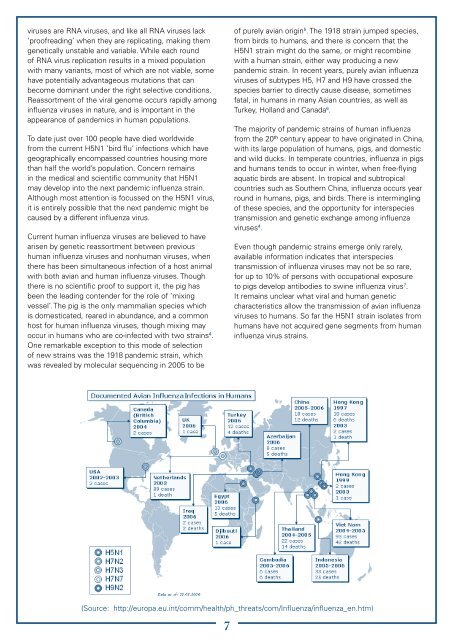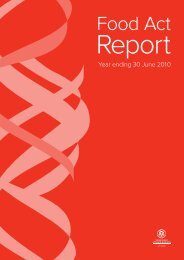References1. Teutsch SM. Considerations in Planning a SurveillanceSystem. In: Teutsch SM, editor. Principles <strong>and</strong>Practice of <strong>Public</strong> <strong>Health</strong> Surveillance. New York:Oxford University Press; 1994.2. Miller M, et al. Australia’s notifiable disease status,2003 Annual report of the National Notifiable<strong>Diseases</strong> Surveillance System. <strong>Communicable</strong>Disease Intelligence. 2005;29(1):1-61.3. Hall G <strong>and</strong> Kirk M. Foodborne illness in Australia.National Centre for Epidemiology <strong>and</strong> Population<strong>Health</strong>. Canberra: OzFoodNet Working Group; 2005.4. Combs BG, R<strong>au</strong>pach JCA, Kirk M. Surveillanceof Shiga toxigenic Escherichia coli in Australia.<strong>Communicable</strong> Disease Intelligence. 2005;29(4):366-369.5. Cameron AS, et al. Community Outbreak of HemolyticUremic Syndrome Attributable to Escherichia coliO111:NM - South Australia, 1995. Morbidity <strong>and</strong>Mortality Weekly Report. 1995;44(29): 550-558.6. Department of <strong>Health</strong> <strong>and</strong> Ageing (DOHA).Surveillance systems reported in CDI, 2006.<strong>Communicable</strong> Disease Intelligence. 2006;30(1):156-160.7. Dicker RC. A brief review of the basic principles ofepidemiology. In: Gregg M, editor. Field Epidemiology.London: Oxford University Press; 2002.8. Hutwager LC, et al. Using Laboratory-BasedSurveillance Data for Prevention: An Algorithm forDetecting Salmonella Outbreaks. Emerging Infectious<strong>Diseases</strong>. 1997;3(3):395-400.Emerging communicablediseases: P<strong>and</strong>emic <strong>and</strong>Avian InfluenzaDr Ann KoehlerBSc, MBBS, FRCPA, MPHConsultant Microbiologist<strong>Communicable</strong> Disease Control BranchDepartment of <strong>Health</strong>A p<strong>and</strong>emic (from Greek pan all + demos people) isan epidemic (an outbreak of an infectious disease) thatspreads across a large region or worldwide.There are three types of influenza virus, A, B, <strong>and</strong> C.Influenza A c<strong>au</strong>ses much of the seasonal influenzaoutbreaks that occur annually, as well as less frequentp<strong>and</strong>emics. Influenza B <strong>and</strong> C are ‘human’ viruses thatare not found in avian hosts, though C viruses havebeen isolated from pigs <strong>and</strong> dogs. Neither types B norC c<strong>au</strong>se p<strong>and</strong>emics <strong>and</strong> both typically c<strong>au</strong>se milderrespiratory illness than influenza A.Influenza A is a zoonotic infection in humans. Its naturalhosts are wild aquatic birds, principally ducks, gulls,<strong>and</strong> waders, in whom it c<strong>au</strong>ses asymptomatic infectionof the gastrointestinal tract 1 . All of the subtypes ofinfluenza A (16 different neuraminidase types [N] <strong>and</strong>9 different haemagglutinin types [H]) can be isolatedfrom these birds. (Neuraminidase <strong>and</strong> haemagglutininare molecules on the surface of the virus involvedin attachment <strong>and</strong> release from host cells, <strong>and</strong> areimportant inducers of antibody response 2 .) They caninfect a wide range of birds <strong>and</strong> mammals, includingaquatic mammals such as whales. When a subtypechanges <strong>and</strong> is able to infect humans readily it maybecome established as a human influenza strain.The origins of recently circulating strains of influenzaA in humans can be traced back to p<strong>and</strong>emics of the20 th century – H1N1 from the 1918-19 ‘Spanish’ flup<strong>and</strong>emic, H2N2 from the 1957-58 Asian flu, <strong>and</strong> H3N2from the 1968-69 Hong Kong flu p<strong>and</strong>emic. Of the threeinfluenza p<strong>and</strong>emics last century, the 1918 p<strong>and</strong>emicwas the worst human disease outbreak ever recorded,c<strong>au</strong>sing acute illness in 30% of the world’s population,<strong>and</strong> killing up to 40 million people, more than thosekilled by the “Black Death”. The first recorded p<strong>and</strong>emicoccurred in 1580, though no doubt they occurred beforethis, <strong>and</strong> 31 have been documented since, most recentlyin 1968-69 3 . It is inevitable that another one will occur,<strong>and</strong> by historical measures it is overdue.Influenza p<strong>and</strong>emics occur when the influenza virusmutates to produce a virulent strain for humans to whichthe existing population has not been exposed. Influenza
viruses are RNA viruses, <strong>and</strong> like all RNA viruses lack‘proofreading’ when they are replicating, making themgenetically unstable <strong>and</strong> variable. While each roundof RNA virus replication results in a mixed populationwith many variants, most of which are not viable, somehave potentially advantageous mutations that canbecome dominant under the right selective conditions.Reassortment of the viral genome occurs rapidly amonginfluenza viruses in nature, <strong>and</strong> is important in theappearance of p<strong>and</strong>emics in human populations.To date just over 100 people have died worldwidefrom the current H5N1 ‘bird flu’ infections which havegeographically encompassed countries housing morethan half the world’s population. Concern remainsin the medical <strong>and</strong> scientific community that H5N1may develop into the next p<strong>and</strong>emic influenza strain.Although most attention is focussed on the H5N1 virus,it is entirely possible that the next p<strong>and</strong>emic might bec<strong>au</strong>sed by a different influenza virus.Current human influenza viruses are believed to havearisen by genetic reassortment between previoushuman influenza viruses <strong>and</strong> nonhuman viruses, whenthere has been simultaneous infection of a host animalwith both avian <strong>and</strong> human influenza viruses. Thoughthere is no scientific proof to support it, the pig hasbeen the leading contender for the role of ‘mixingvessel’. The pig is the only mammalian species whichis domesticated, reared in abundance, <strong>and</strong> a commonhost for human influenza viruses, though mixing mayoccur in humans who are co-infected with two strains 4 .One remarkable exception to this mode of selectionof new strains was the 1918 p<strong>and</strong>emic strain, whichwas revealed by molecular sequencing in 2005 to beof purely avian origin 5 . The 1918 strain jumped species,from birds to humans, <strong>and</strong> there is concern that theH5N1 strain might do the same, or might recombinewith a human strain, either way producing a newp<strong>and</strong>emic strain. In recent years, purely avian influenzaviruses of subtypes H5, H7 <strong>and</strong> H9 have crossed thespecies barrier to directly c<strong>au</strong>se disease, sometimesfatal, in humans in many Asian countries, as well asTurkey, Holl<strong>and</strong> <strong>and</strong> Canada 6 .The majority of p<strong>and</strong>emic strains of human influenzafrom the 20 th century appear to have originated in China,with its large population of humans, pigs, <strong>and</strong> domestic<strong>and</strong> wild ducks. In temperate countries, influenza in pigs<strong>and</strong> humans tends to occur in winter, when free-flyingaquatic birds are absent. In tropical <strong>and</strong> subtropicalcountries such as Southern China, influenza occurs yearround in humans, pigs, <strong>and</strong> birds. There is interminglingof these species, <strong>and</strong> the opportunity for interspeciestransmission <strong>and</strong> genetic exchange among influenzaviruses 4 .Even though p<strong>and</strong>emic strains emerge only rarely,available information indicates that interspeciestransmission of influenza viruses may not be so rare,for up to 10% of persons with occupational exposureto pigs develop antibodies to swine influenza virus 7 .It remains unclear what viral <strong>and</strong> human geneticcharacteristics allow the transmission of avian influenzaviruses to humans. So far the H5N1 strain isolates fromhumans have not acquired gene segments from humaninfluenza virus strains.(Source: http://europa.eu.int/comm/health/ph_threats/com/Influenza/influenza_en.htm)
















